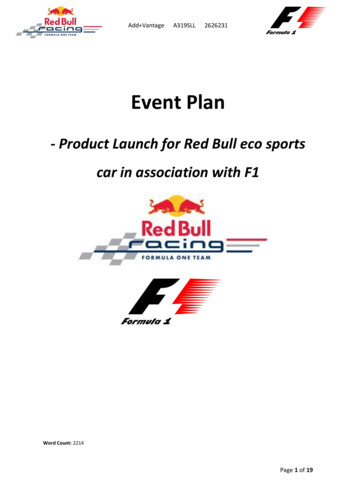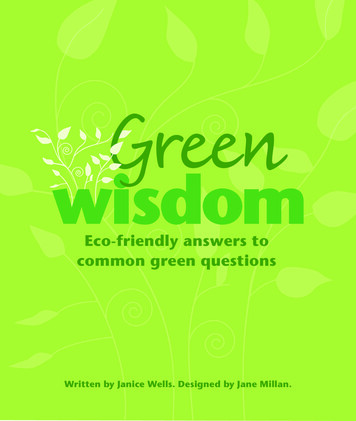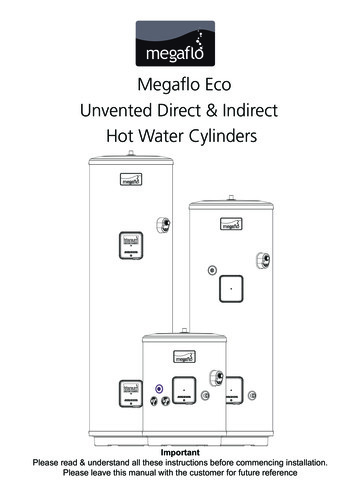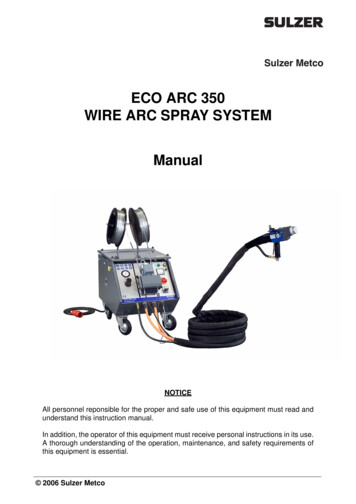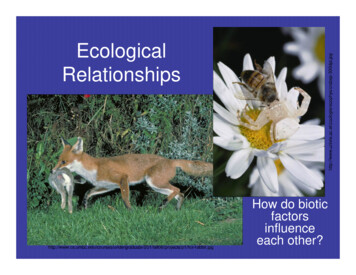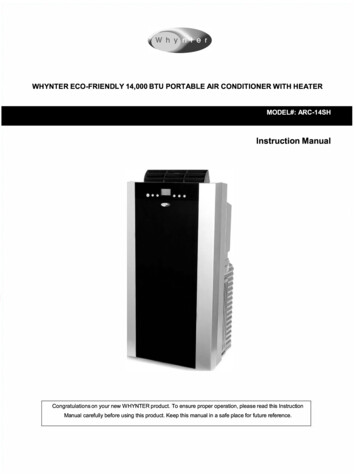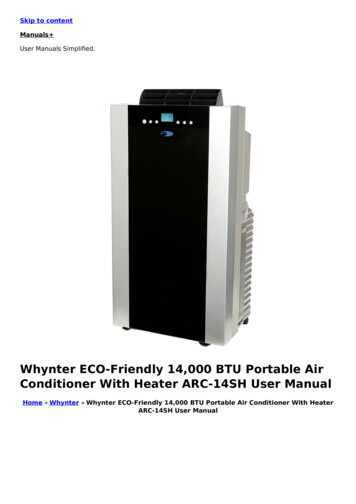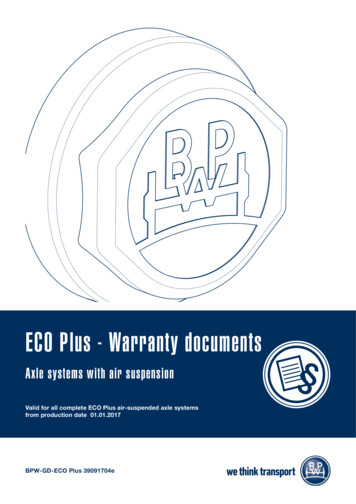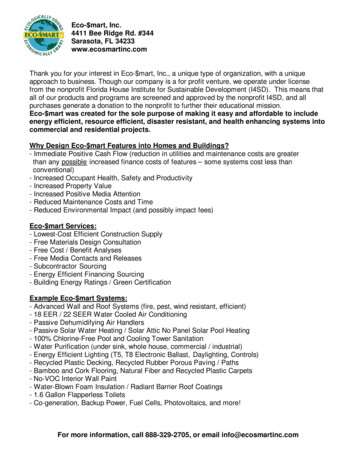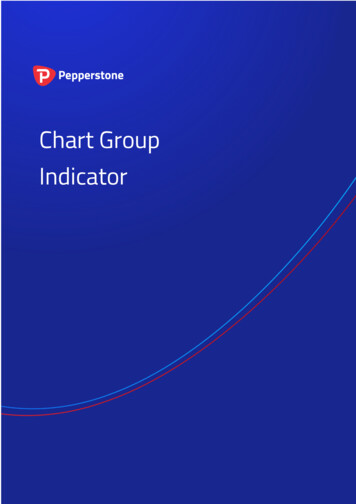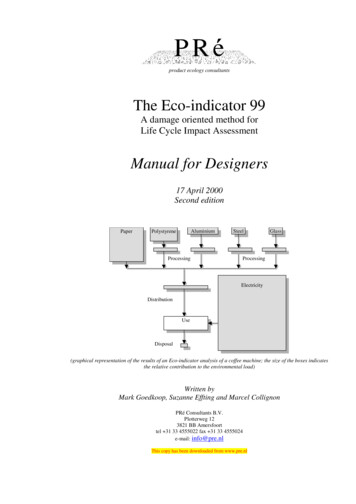
Transcription
product ecology consultantsThe Eco-indicator 99A damage oriented method forLife Cycle Impact AssessmentManual for Designers17 April 2000Second phical representation of the results of an Eco-indicator analysis of a coffee machine; the size of the boxes indicatesthe relative contribution to the environmental load)Written byMark Goedkoop, Suzanne Effting and Marcel CollignonPRé Consultants B.V.Plotterweg 123821 BB Amersfoorttel 31 33 4555022 fax 31 33 4555024e-mail: info@pre.nlThis copy has been downloaded from www.pre.nl
The Eco-indicator 99Manual for DesignersPRé Consultants B.V.ContentsPREFACE . 31.THE APPLICATION OF STANDARD ECO-INDICATORS . 11.1.1.2.1.3.1.4.1.5.1.6.1.7.2.STANDARD ECO-INDICATORS . 1ENVIRONMENTAL EFFECTS OF PRODUCTS . 1THE “ECO” WE INDICATE . 2DIFFERENCES WITH THE ECO-INDICATOR 95. 2USES AND LIMITATIONS . 3ISO AND THE ECO-INDICATORS . 3THE UNIT OF ECO-INDICATORS . 3DESCRIPTION OF THE STANDARD ECO-INDICATORS. 5Production of materials . 5Production processes . 5Transport . 5Energy. 5Waste processing and recycling. 63.OPERATING INSTRUCTIONS . 84.EXAMPLE . 114.1.SIMPLE ANALYSIS OF A COFFEE MACHINE . 11Step 1: Establish the purpose of the Eco-indicator calculation . 11Step 2: Define the life cycle. 11Step 3: Quantify materials and processes . 11Step 4: Fill in the form . 12Step 5: Interpret the results. 13Verification . 13Improvements. 134.2.EXAMPLE OF A COMPLEX PRODUCT. 145.THE ECO-INDICATOR 99 METHODOLOGY . 155.1.THREE STEPS . 155.2.WEIGHTING (STEP 3) . 155.3.THE DAMAGE MODEL (STEP 2) . 16The damage model for emissions . 16Damage model for land-use. 17Damage model for resources . 185.4.INVENTORY OF THE PROCESSES (STEP 1). 195.5.UNCERTAINTIES . 19Uncertainties about the correctness of the model. 19Data uncertainties. 20LITERATURE. 22Stay updated via the Eco-indicator 99 e-mail user groupIn order to receive feedback from you and to be able to send updates we have established a free e-mail user group. Thediscussion will be monitored and controlled by the development team. This team will encourage factual and concisediscussions focussed especially on the Eco-indicator 99 applications and the methodology.To join the Eco-indicator Internet User Group simply send an empty e-mail to: join-eco-indicator@lists.lyris.netAfter confirmation you receive a welcome message with simple instructions and some “house” rules. From that moment,until you unsubscribe you will receive all e-mail send to the user group and of course, you can send e-mail yourself.
The Eco-indicator 99Manual for DesignersPRé Consultants B.V.PrefaceSustainable production and consumption can only be achieved if all market actors take their ownresponsibility. The ultimate goal is therefore taking into account environment in every decisionmaking process by industry, retailers and consumers. This is a steadily growing process that needsto be fostered by sufficient incentives both from the demand as the supply side. To this end acomprehensive set of policy instruments has been developed in the Netherlands under the label ofIntegrated Product Policy (IPP).At the centre of IPP is the introduction of Product Oriented Environmental Management System[POEM] which is being developed in a concerted action both by industry and by government inrecent years. The objective of POEM is to establish a systematic drive for continuous improvementof the life cycle environmental performance of products within all sorts of enterprises byintegrating environmental aspects in strategic management decisions.POEM has to be seen as an elaboration of Environmental Management System that focusesparticularly on product development and product (re)design. The complexity of the decisionprocess involving all environmental aspects means very often an unbridgeable gap for designers.Although life cycle assessment [LCA] is a good tool to assess the environmental performance of aproduct, and although it is widely used by designers, LCA is time consuming and costly. Designershave to make many decisions especially when designing complex products. Moreover the results ofLCA are mostly not straightforward in favour of one product or material design over the alternativeone. Results of LCA have to be interpreted or weighed. The Eco-indicator 95 methodology is anLCA weighing method specially developed for product design. This method has proved to be apowerful tool for designers to aggregate LCA results into easily understandable and user-friendlynumbers or units, the so-called Eco-indicators.The Eco-indicator ’95 methodology is being used very often by designers but is criticised byenvironmental experts at the same time because some environmental aspects were not accountedfor in the method. The new Eco-indicator 99 method includes many more aspects and is thereforemore complex than the 95 version but the resulting Eco-indicators are still the same user-friendlyunits.The weighing system between the different environmental aspects - the core of the Eco-indicatormethod - has also been changed. The 1995 Eco-indicator used the so-called Distance-to-Targetapproach. This method was criticised because there was no clear-cut objective way to definesustainable target levels. This problem is in the present Eco-indicator method avoided byintroducing a damage function approach. The damage function presents the relation between theimpact and the damage to human health or to the ecosystem.Contributions of many LCA experts have been merged in this 99 method. I would particularlyacknowledge the contributions from several Swiss Experts and of the National Institute of PublicHealth and the Environment [RIVM].The Eco-indicator 99 does reflect the present state of the art in LCA methodology and application.This of course does not mean that all problems are solved. Further developments in environmentalscience, material technology and LCA methodology will take place and should result in futureimprovements of the Eco-indicator. But we are convinced that the revised Eco-indicatormethodology is sufficiently robust to play an important role in eco-design for the next years.I hope the Eco-indicator 99 method and the resulting Eco-indicators shall contribute to theincorporation of environment in product development decisions.Director Industry- and Consumer PolicyJan Suurland
The Eco-indicator 99Manual for DesignersPRé Consultants B.V.
The Eco-indicator 99Manual for DesignersPRé Consultants B.V.1. The application of standard Eco-indicatorsThis manual is intended to be used by for designers and product managers that want to apply thestandard Eco-indicator values for the assessment of environmental aspects of product systems.Although the application of these standard values is basically very simple it is very important tounderstand some of the backgrounds, the features and the limitations. This manual aims to give thisinformation.1.1.Standard Eco-indicatorsStandard Eco-indicators are numbers that express the total environmental load of a product orprocess. These indicators can be found on separate pages in the back cover of this report. Withappropriate LCA software it is possible to calculate additional indicators. News about updates andadditional indicators can be obtained by registering in the internet Eco-indicator usergroup (see textbox on the contents page).With the standard eco-indicators any designer or product manager can analyse the environmentalloads of products over the life cycle. Next to this different design alternatives can be compared.This report describes the application of the standard indicators as well as the inherent limitations.The standard Eco-indicators are calculated with a rather complex methodology. This methodologyis summarised in a popular way in chapter 5. For an in depth description we refer to theMethodology report “The Eco-indicator 99 Methodology report” and the annexe report. These canalso be found on the internet (www.pre.nl).1.2.Environmental effects of productsEvery product damages the environment to some extent. Raw materials have to be extracted, theproduct has to be manufactured, distributed and packaged. Ultimately it must be disposed of.Furthermore, environmental impacts often occur during the use of products because the productconsumes energy or material. If we wish to assess a product’s environmental damage, all it's lifecycle phases must therefore be studied. An environmental analysis of all the life cycle phases istermed a Life Cycle Assessment, or LCA for short1.To date, a designer, wishing to use life cycle assessments in the design process, has been faced bytwo major problems :1.The result of a full life cycle assessment is difficult to interpret. Within a life cycleassessment it is possible to determine the contribution of a product life cycle to thegreenhouse effect, acidification and other environmental problems while the totalenvironmental impact remains unknown. The reason is the lack of mutual weighting of theenvironmental effects.2.In general the careful collection of all the environmental data in a product’s life cycle iscomplex and time-consuming. As a result extensive LCAs cannot usually be carried outduring a design process.The Eco-indicator project has resolved these problems as follows:1.The LCA method has been expanded to include a weighting method. This has enabled onesingle score to be calculated for the total environmental impact based on the calculatedeffects. We call this figure the Eco-indicator.2.Data have been collected in advance for the most common materials and processes. TheEco-indicator has been calculated from this. The materials and processes have been defined1Frequently a distinction is made between full and screening LCAs. Screenings are often
The Eco-indicator 99 Manual for Designers PRé Consultants B.V. Preface Sustainable production and consumption can only be achieved if all market actors take their own responsibility. The ultimate goal is therefore taking into account environment in every decision making process by industry, retailers and consumers. This is a steadily growing .
